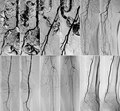Digital variance angiography
Digital Variance Angiography (DVA) is an advanced imaging technique used in the medical field to visualize the blood vessels in the body. This method is a refinement of traditional angiography, providing clearer, more detailed images of the vascular system. DVA is particularly useful in diagnosing and evaluating conditions related to the arteries and veins, such as blockages, aneurysms, and vascular malformations.
Overview[edit]
Digital Variance Angiography combines digital imaging technology with a contrast medium injected into the bloodstream. The contrast medium enhances the visibility of the blood vessels in the digital images. DVA employs sophisticated algorithms to subtract the background tissues from the images, allowing for a clear view of the vascular structures without the interference of surrounding bones and organs.
Procedure[edit]
The DVA procedure begins with the insertion of a catheter into a blood vessel, usually through a small incision in the groin or arm. A contrast agent is then injected into the bloodstream through the catheter. As the contrast agent flows through the vascular system, a series of rapid digital images are taken. These images are processed in real-time to highlight the blood vessels and identify any abnormalities.
Applications[edit]
Digital Variance Angiography is used in various medical specialties, including cardiology, neurology, and vascular surgery. Its applications include:
- Diagnosing and assessing the severity of coronary artery disease
- Evaluating cerebral aneurysms and arteriovenous malformations in the brain
- Planning interventions for peripheral arterial disease
- Assessing the vascular system before and after surgical procedures
Advantages[edit]
DVA offers several advantages over traditional angiography methods:
- Enhanced image quality allows for better diagnosis and treatment planning.
- Reduced exposure to radiation for both the patient and medical staff.
- The ability to process and analyze images in real-time facilitates immediate decision-making during procedures.
- Minimally invasive, with less discomfort and shorter recovery time for patients.
Risks and Considerations[edit]
While Digital Variance Angiography is generally safe, it carries some risks associated with the use of contrast agents and the invasive nature of the procedure. These risks include allergic reactions to the contrast medium, bleeding at the catheter insertion site, and potential damage to the blood vessels. Patients with kidney problems may also be at increased risk due to the contrast agent used during the procedure.
Future Directions[edit]
The field of Digital Variance Angiography is continuously evolving, with research focused on improving image quality, reducing radiation exposure, and expanding the applications of DVA. Developments in software algorithms and imaging technology promise to enhance the capabilities of DVA, making it an even more valuable tool in diagnosing and treating vascular diseases.
-
Digital variance angiography
-
Digital variance angiography
-
Digital variance angiography
Ad. Transform your life with W8MD's Budget GLP-1 injections from $75


W8MD offers a medical weight loss program to lose weight in Philadelphia. Our physician-supervised medical weight loss provides:
- Weight loss injections in NYC (generic and brand names):
- Zepbound / Mounjaro, Wegovy / Ozempic, Saxenda
- Most insurances accepted or discounted self-pay rates. We will obtain insurance prior authorizations if needed.
- Generic GLP1 weight loss injections from $75 for the starting dose.
- Also offer prescription weight loss medications including Phentermine, Qsymia, Diethylpropion, Contrave etc.
NYC weight loss doctor appointmentsNYC weight loss doctor appointments
Start your NYC weight loss journey today at our NYC medical weight loss and Philadelphia medical weight loss clinics.
- Call 718-946-5500 to lose weight in NYC or for medical weight loss in Philadelphia 215-676-2334.
- Tags:NYC medical weight loss, Philadelphia lose weight Zepbound NYC, Budget GLP1 weight loss injections, Wegovy Philadelphia, Wegovy NYC, Philadelphia medical weight loss, Brookly weight loss and Wegovy NYC
|
WikiMD's Wellness Encyclopedia |
| Let Food Be Thy Medicine Medicine Thy Food - Hippocrates |
Medical Disclaimer: WikiMD is not a substitute for professional medical advice. The information on WikiMD is provided as an information resource only, may be incorrect, outdated or misleading, and is not to be used or relied on for any diagnostic or treatment purposes. Please consult your health care provider before making any healthcare decisions or for guidance about a specific medical condition. WikiMD expressly disclaims responsibility, and shall have no liability, for any damages, loss, injury, or liability whatsoever suffered as a result of your reliance on the information contained in this site. By visiting this site you agree to the foregoing terms and conditions, which may from time to time be changed or supplemented by WikiMD. If you do not agree to the foregoing terms and conditions, you should not enter or use this site. See full disclaimer.
Credits:Most images are courtesy of Wikimedia commons, and templates, categories Wikipedia, licensed under CC BY SA or similar.
Translate this page: - East Asian
中文,
日本,
한국어,
South Asian
हिन्दी,
தமிழ்,
తెలుగు,
Urdu,
ಕನ್ನಡ,
Southeast Asian
Indonesian,
Vietnamese,
Thai,
မြန်မာဘာသာ,
বাংলা
European
español,
Deutsch,
français,
Greek,
português do Brasil,
polski,
română,
русский,
Nederlands,
norsk,
svenska,
suomi,
Italian
Middle Eastern & African
عربى,
Turkish,
Persian,
Hebrew,
Afrikaans,
isiZulu,
Kiswahili,
Other
Bulgarian,
Hungarian,
Czech,
Swedish,
മലയാളം,
मराठी,
ਪੰਜਾਬੀ,
ગુજરાતી,
Portuguese,
Ukrainian



